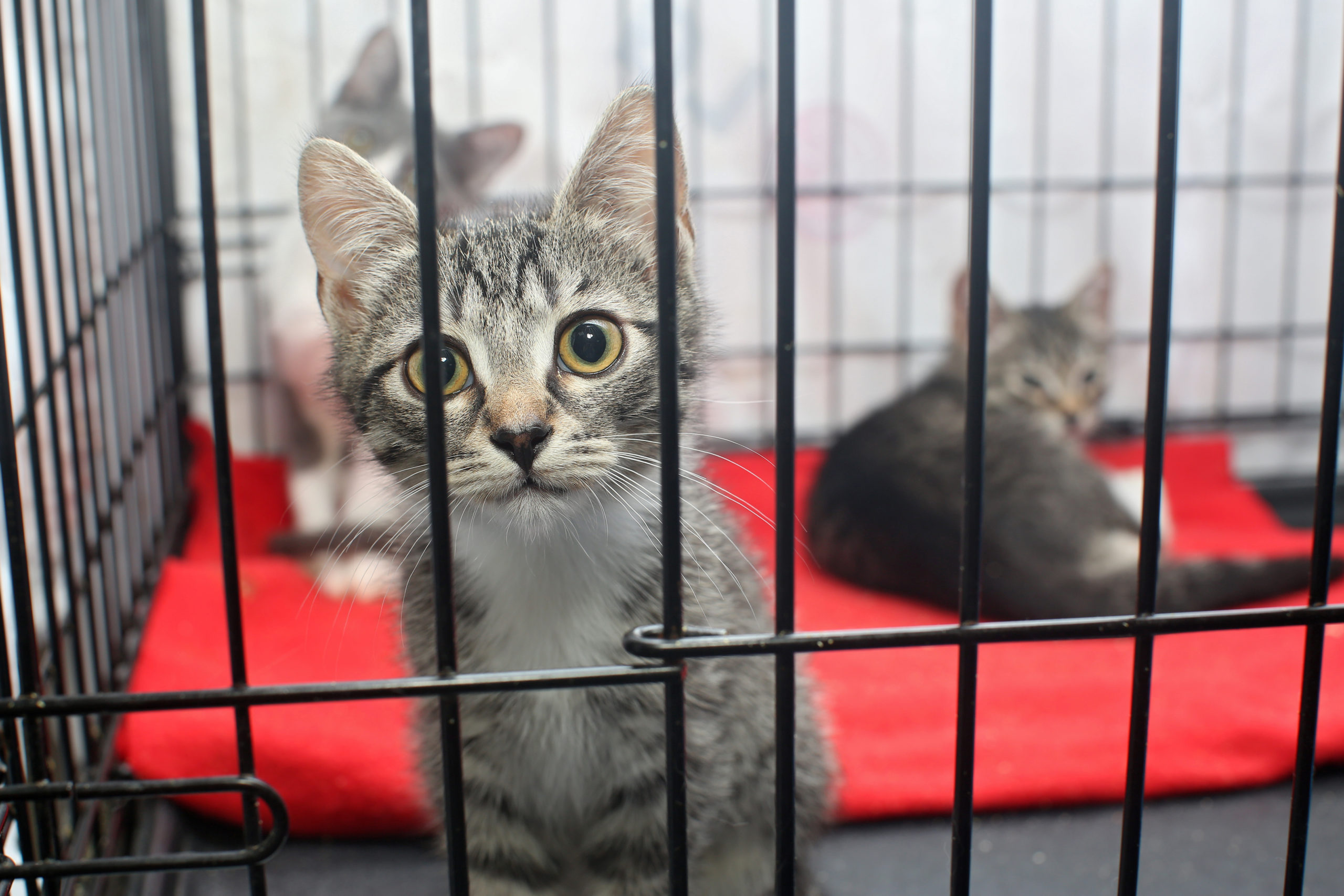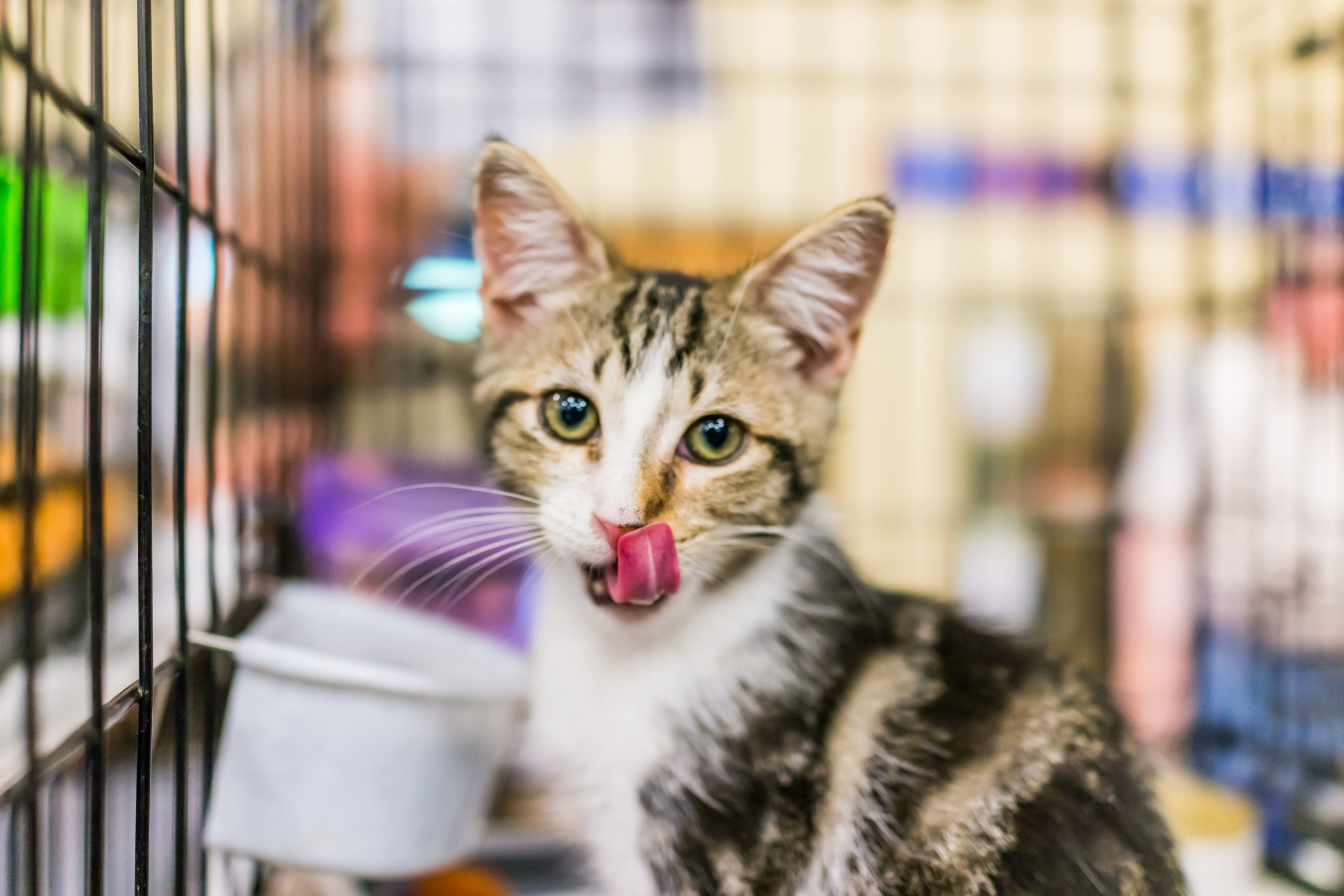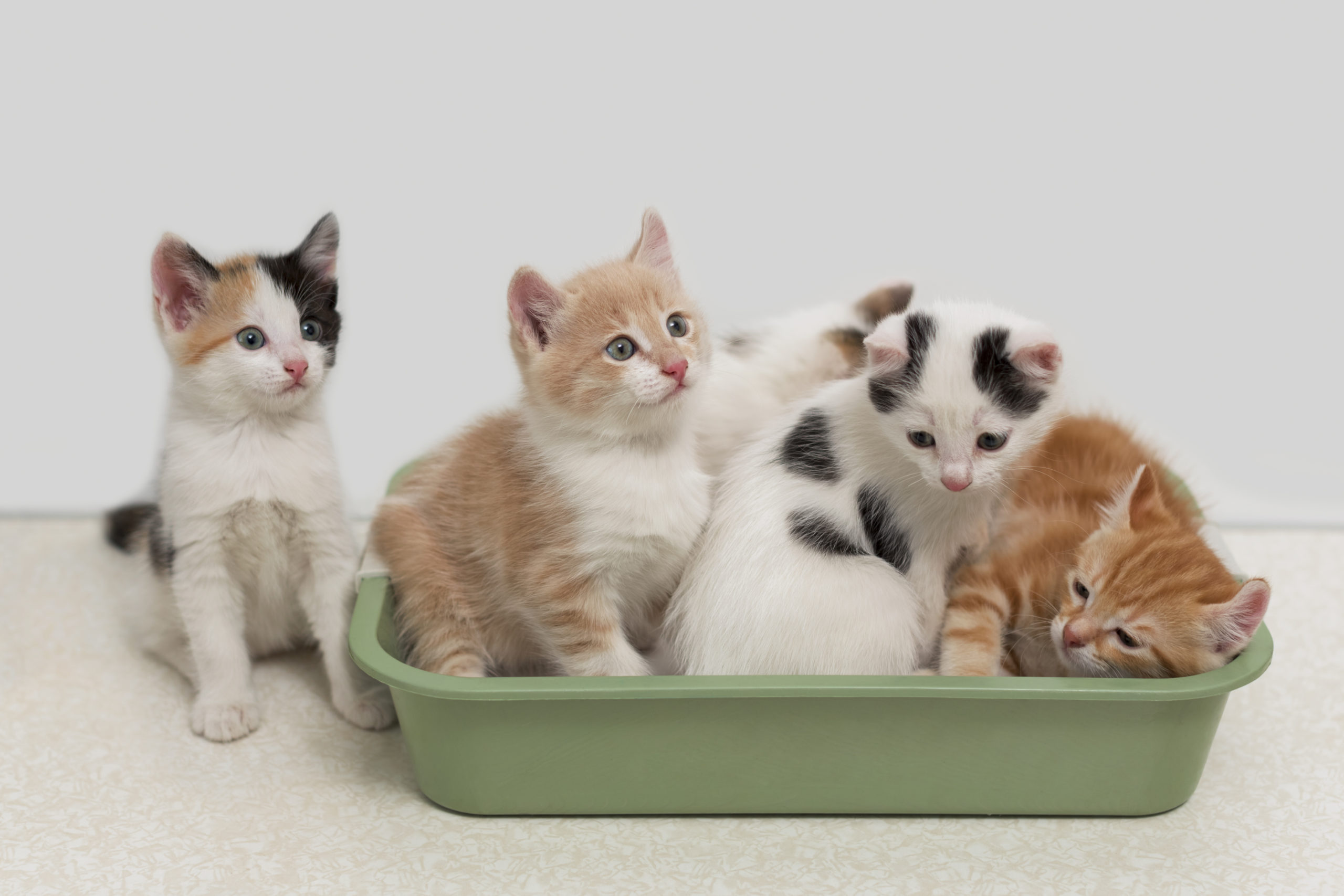Ready to Get Started Fostering Cats or Kittens?
Yes!!! You’ve made the decision to be a life saver! This is very exciting. Welcome!
Before you commit to your first foster cat, read the tips below to make sure you’re all set. This article will touch on the first steps to getting started, things you should make sure to know and do before bringing home your first foster cat, a list of items you’ll need to foster cats, how to set up your foster space, and things you should do once your foster cat is home with you.

First Steps
Do a Little Reading
Researching, like you’re doing right now, is a great start! Also be sure to read about the shelter and rescue organizations local to you. A simple Google search will lead you to their websites and Facebook pages, which should include their mission statements, more information about their foster programs, as well as reviews of the organization. You will want to learn about what types of fostering they need, their foster program’s expectations and processes, and what they offer in terms of medical care and supplies. You may need to ask these things specifically by emailing or calling to talk to whomever manages their foster program.TIP: Want a little help? We created a resource just for you! Visit stayhomeandfoster.org to sign up to be connected with a local organization in need of foster parents.
Apply
Each organization will have a slightly different application process, but many have moved their processes online, especially since the Covid-19 crisis. Most are moving towards questionnaire style applications and open conversations, and away from home checks, lease checks, and vet references. Be prepared to answer questions honestly and ask your questions too, remembering that everyone’s intentions are to save lives while placing cats in foster homes where their needs can be met.TIP: After submitting your application to foster, try to be patient. It’s an exciting moment, but sometimes the staff and volunteers handling the applications have their hands full. In fact, some smaller rescue organizations are run solely by volunteers, so they are doing all of this life saving on top of their “regular” jobs. Be kind, patient, but persistent. Most organizations definitely need your help! Try to follow-up if you don’t hear back.
Training
Before taking home your first foster cat, be sure you receive the organization’s version of foster orientation, training, or counseling. Many organizations are moving towards online orientation and may also provide a handbook with information and additional resources. They likely will cover things like their expectations, foster care and adoption policies, your main contacts, support options, and instructions on both routine and emergency medical care.Foster Matchmaking
Be sure to tell the organization if you have any limitations such as time, money, transportation, or space. Tell them your experience level with cats and kitten care including handling medical issues or behavior modification work. This information will help them match you with the right type of foster cat. And if you’re ready to expand your experience level and learn something new, like how to bottle feed neonatal kittens or how to provide supportive care to a sick cat, definitely let them know that you want to help and are open to more training!Experience
No one is a perfect foster parent right away. We promise that each time you foster, you will feel more confident and your experience and the things you learn will always benefit the next cat! All foster parents are constantly building their knowledge base.Don't Hesitate to Ask Questions
If you’re feeling a little lost at the beginning, you’re not alone! Many new foster parents feel a bit overwhelmed, in over their heads, or isolated during their first foster experience. You’ll always want to reach out first to the person or people at your shelter or rescue who run the foster program, as they will have answers to lots of your questions. You can also ask if they can put you in touch with other foster parents who might be interested in mentoring brand new foster parents. Asking questions and building your own little go-to foster community makes a world of a difference! That’s why we’ve also created this community just for you.
Before Bringing Home a New Foster

Mindset
Remind yourself of your goals of fostering before you even bring home a new foster.Your Pets
Be sure your resident pets are up-to-date on their vet-recommended vaccines and flea treatment. We also strongly recommend that your pets are spayed/neutered, if possible, for a few reasons. First, spay/neuter is a very big part of the animal welfare mission and a key part in preventing and tackling pet overpopulation. Second, it will help to alleviate some territorial behaviors on their part that could arise from bringing home a foster cat. Lastly, to prevent any pets in the home from getting pregnant (or impregnating another cat) if they accidentally get out of your house or interact with a foster cat who isn’t yet altered.Vet Care
Be sure to understand the level of medical care the organization can and will provide to your foster cat. Know the procedures for routine vet care and what to do if an emergency arises. If your foster cat is sick or injured, make sure you understand the treatment plan for your foster cat and contact the organization you’re working with right away if you have any questions.Basic Cat Care
It’s important to understand basic cat care for the type of cat or kitten(s) you will be fostering, whether it’s tiny kittens or a senior cat. They all need something a little different.Learn all about caring for kittens, including bottle feeder kittens, weaning kittens, kittens eating on their own, and nursing mother cats with kittens from our friend, Kitten Lady!
Fostering an adult cat? Social, friendly, and healthy adults cats typically just need a balanced diet, fresh water, a clean litter box, lots of enrichment, and time with you. They are typically considered very adoptable and likely won’t need to stay in foster care for too long.
The adult cats that need foster care the most are injured, sick, fearful, and senior cats. These types of cats need a bit more TLC, sometimes a little, sometimes a lot. Be sure to talk with the organization you’re fostering for about the cat’s needs, treatments, and the likely time commitment needed from you. Some cats will need several weeks to several months in foster care. BUT, a mild injury or surgery that requires crate rest, a cat with a mild kitty cold, or a shy cat that is getting overlooked and needs a break from the shelter, are often easier to foster (and require less time in foster care) than a cat with a severe injury, a severe illness, a senior medical issue, or a more challenging behavior issue.
Besides the medical care or socialization time needed, adult cats need an appropriate diet (that they like), fresh water, a clean litter box or two, enrichment, and time spent with you! Be sure to check back often for new resources on cat care.
Flea Tips
We just want to give you a heads up about fleas. With a little caution, it’s easy to tackle fleas, but be prepared to treat them, especially in kittens! Some of the cats brought to shelters have been outdoors or poorly cared for and come in with fleas. It’s not the shelter’s fault, but fleas can quickly cause anemia, which is especially harmful to kittens!Ask the organization you’re fostering for if your foster cat has already been treated for fleas or if, and how, they need to be treated by you. Most adult cats can receive oral or topical flea treatment from the organization you’re fostering for. Many treatments have proven to be harmful to cats, so please don’t ever give your foster cat flea treatment without the organization’s approval. Also, bathing adult cats is really stressful for them so it should be avoided.
For kittens, the organization you’re working with may have treatment options so check with them, but they may need a bath to help remove fleas. (Side note, they may need the occasional butt bath, too!) There are times when kittens are too young, fragile, or sick for a bath, so be sure to learn all about safely bathing kittens from our friend, Kitten Lady.
Basic Cat Behavior
For everyone’s sake, you, your household, your foster cat, and your other pets, it’s really important to learn and understand cat behavior. Cat behavior is so misunderstood in so many homes, but we are working to change that and we need your help! We need YOU to learn all about cat behavior, to become an advocate for cats, and teach others how to work through behavior issues!Cats need consistency, balance, and enrichment in their lives to be confident, and a confident cat is a happy cat. Their confidence relies heavily on feeling safe in their space, and as our friend, Jackson Galaxy says, they need this confidence to find their mojo.
Even domestic cats have prey drive and rather than trying to ignore it, we should do our best to support their natural cycle of hunt, catch, kill, eat, and sleep.
What are some of the best ways to meet a cat’s basic needs?
- Routine playtime using an interactive toy that allows them to hunt, catch, and “kill”! End on a positive note, allowing them to catch their “prey” and then give them a treat at the end of a play session. Learn more about playtime here.
- If possible, offer your foster cat comfy places to look out a door or window. The natural activity outside can provide them with hours of easy and free enrichment!
- Catify your foster space (and your home)! Is this the first time you’re hearing the term Catify? Catifying refers to creating an enriched environment where cats can truly thrive and live their best lives. Check out Jackson’s intro to the world of Catification in this video!
- Did you know that you can clicker train cats the same way you can with dogs! Cats are incredibly smart and training gives them a great way to channel their energy. Bonus! Video their cool new behaviors like “sit” or “high-five” to show off for potential adopters! Learn how to clicker train your foster cat here!

TIP: All desired cat behavior can be reinforced using things your foster cat loves! This could be delicious treats, food, or petting (whatever they like best). This is called Positive Reinforcement! Rather than punishing a cat for undesired behaviors, ignore them, walk away, and aim to positively reinforce good behaviors. Learn more about using positive reinforcement to train your cat in this video from Jackson.
To get more tips on specific behavior questions or issues, such as litter box set-ups or understanding feline zoomies, check out Jackson’s resources here.
Learn more about your foster cat from Jackson here. He also has Five Tips for Your New Foster Cat.
Items You Will Need

Source
Fostering can require you to spend some money on supplies, but not always. Check with the organization that you’re fostering for about what items they supply, if they provide ongoing supplies, or if you’re responsible for everything. If the organization isn’t able to provide supplies, don’t let that discourage you from helping them! You can rally your friends, family, and social media followers to help you foster by creating wish lists or asking for specific items. Many people who don’t feel like they can foster still want to help and will be happy to send you supplies you need!Nutrition
Provide food that offers the appropriate nutrition for the type of cat or kittens you will be fostering. It may take more than one try to find a type of food they like. Always ask the organization if the cat is on a particular type of food or if they recommend a particular brand. If the cat is on a special/prescription diet (for example, for allergies or for urinary tract issues), the shelter or rescue will typically provide that prescription food for you. And when in doubt about the right food, ask!Bowls
Stock up on food and water bowls. They don’t need to be fancy, but be sure to keep them clean to prevent bacteria from growing. We strongly recommend using stainless steel or ceramic bowls. You’ll want to avoid plastic bowls if possible because plastic can be harder to sanitize and can cause allergies or cat acne.Toys for Playtime
Routine playtime is so important for a cat! Finding their favorite toys will help them be successful in their forever home. You will want to have a variety of toys on hand including interactive and independent play toys. Interactive toys are those that you will need to play with your foster cat, like a feather wand. You’ll also want to provide plenty of independent toys, whether they’re made specifically for cats or are home-made! Cats like batting around things like springs, balls, crinkley materials, bottle caps, fake stuffed mice or birds. Paper bags or cardboard boxes, and food puzzles like toilet paper rolls filled with treats prove to be tons of enriching fun! Check out ways to make your own toys!TIP: It’s really important that you avoid allowing your foster cat or kittens to play rough with your arms, hand, feet, etc. to avoid sending them to their adoptive home with bad habits that could result in long term behavior issues or cause them to be returned.
Scratchers
Scratching is a natural cat behavior! Yes, we’re shouting it. We want them to scratch and they need to scratch. Of course we want to encourage them to scratch on the appropriate places, but they will need options! Give your foster cat both horizontal and vertical surfaces to scratch on. Cardboard scratchers, old carpet pieces, and sisal material are all great and affordable. Try a variety of materials, as your cat may have a preference. It’s important to use positive reinforcement when they scratch on on the right surfaces, so be sure to give them a treat, a pet, or a happy “good boy” (whatever they seem to like best) when they scratch appropriately. This reinforces their good behavior! Do not punish the cat for scratching in a spot you’d rather they don’t scratch. Instead, try placing their favorite type of scratching surface near the area you’d rather they didn’t scratch on.Bedding
Offer several cozy, clean bedding options, in different locations and heights. Options could include fleece blankets, thick towels, cat beds, and hidey huts. Unless bedding is soiled, don’t wash it too frequently because it will have your foster cat’s scent on it, providing them with some confidence.Litter Box
Provide appropriately-sized litter boxes, and choose litter boxes that are easily accessible for the kind of cat or kitten you are fostering. For example, senior cats will need litter boxes with at least one low side so it is easier to climb into. And most cats do not like covers on their litter boxes because they restrict their ability to move freely and comfortably. For the number of litter boxes, the rule of thumb is 1 litter box per adult cat + 1 additional litter box. If your foster cat is going outside the litter box, try a different type of litter, a different litter box size, change the litter box location, and most importantly, alert the organization you’re fostering for in case it is a medical issue, especially if they are straining or seem to be in pain. There are many resources out there that deal with litter box issues.Litter
Try to avoid fragrant litters, as many cats don’t like them and they can cause your home to smell like poopy potpourri. Use natural litters for kittens because they may decide to play in it or even possibly eat it. And don’t forget a litter scooper!Heat Source
Kittens and sick cats will need help regulating their body temperatures. You can buy a microwavable disc that stays warm for several hours or there are many other ways to make your own safe heat source including rice in a sock or a bottle filled with hot water wrapped in a blanket or towel. Learn more about heat sources here. Be sure the cat has a spot to move away from the heat if it is too hot for their comfort.Other Handy Items
- Cleaning supplies, like a broom, cleaning wipes or spray, and paper towels
- Brushes, nail clippers, and baby wipes
- A white board or notebook to keep track of things like eating frequency, behavior, and/or weight gain/loss
- Extra clean bedding and towels
- Plastic bags for trash and scooping litter
- Puppy pads for under litter pans or food dishes, especially for messy kittens
- Kitchen scale to weight kittens
- Pheromone diffusers help cats relax!
Setting Up Your Foster Space

Where
The best place to first place your foster cat is in a safe, secure space in the home with a door to that space that can be closed. A spare bathroom, bedroom, basement area, or any other safe, quiet space will work great. Young kittens will need smaller enclosures inside of this space, like playpens. As they grow, their living space can grow too. Learn more about safe and appropriate enclosures for kittens here.Cat-Proofing
You will want to take the time to cat-proof the space for the cat’s safety and to remove any valuable or sentimental items that you don’t want to see damaged. Look out for things they could ingest or get caught in, like cords, and secure any window screens, holes in walls, or vents where they could escape. You should also block off any under areas, like under the bed or furniture to encourage the cat to hide in the areas you provide.Basecamp!
Coming to a new home can be scary and overwhelming to a foster cat, especially if they’ve never lived indoors before. We never want to walk in the door with a new foster cat and just open the carrier, giving them access to the whole home. It’s just too much at once and likely will result in them hiding in a place that you can’t reach. They may not come out or eat for days. The stress could also make them sick. Even if your foster cat or kitten is friendly, please have a safe space in your home for them to slowly adjust and call their own. Our friend, Jackson Galaxy, calls this space their Basecamp!Scent Soakers
Porous materials in the room that the cat rubs against so that it smells like them. Cats are very territorial and mark things by rubbing against them so they feel “ownership” and confidence. Pillows, toys, blankets, beds, scratchers, litter boxes, and bowls will all start to smell like your foster cat and it will help them adjust and feel safe!Placement of Litter Box, Food, Water, Toys, and Scratchers
There’s really no specific way to set up these items, since everyone’s rooms are different. Set up the food and water bowls far away from the litter boxes. Cats (like people) do not like to eat where they go to the bathroom. It’s a good idea to keep most items away from the litter boxes to avoid litter from getting kicked on them. That’s where a broom comes in handy!Scatter independent play toys throughout the space, but your foster cat will hopefully move them around while playing! Be sure to provide both vertical and horizontal scratchers, and if your foster cat starts scratching on other surfaces, move the scratchers closer to that area, add more options, or place a little catnip on the scratcher to entice them to start using it!
Bedding & Hiding Area Placement
Provide several comfortable surfaces and hiding places that aren’t under the bed or furniture. They should be placed at a variety of heights, but nowhere completely out of reach. Provide areas on the floor, at window sill height, on desks/dresser surfaces, in storage cubbies, closets, and high up. Be creative and remember that cats LOVE curling up in boxes, so you don’t need to buy anything expensive. Check out this great DIY idea for creating a cozy hiding spot.TIP: It is very important to provide cozy hiding places and comfy perches for your foster cat, but when setting up your foster space, be sure that the hiding places and perches you provide are not difficult for you to get to in an emergency. For example, it’s better to offer a large cardboard box draped with a sheet, placed in the corner of the room, than to have under-the-bed be the only available hiding space. Try to block off areas that a cat could get to that would make it very difficult or impossible for you to reach the cat in an emergency, and instead offer safe, cozy alternatives for hiding and perching.
Cat Carrier
One big thing we recommend is to leave a cat carrier in the foster space with the carrier door open and a soft blanket inside. By leaving the carrier in the room, it becomes another safe space rather than something that’s only used when they’re going to the vet or shelter. You can also place food or treats inside the carrier, and then give the cat a high value treat when they’re inside the carrier. This will create a positive association with the carrier. Wondering how to get your cat into the cat carrier? Check out this video from Jackson.Get Organized
You’ll quickly learn that you may want to keep a few supplies handy and ways to keep yourself organized in your foster space. Be sure to place any harmful items securely and out of reach (examples: plastic bags, cleaning solutions, medications, toys that should only be used under supervision).
Once Your Foster Cat is Home

Isolation & Adjustment Period
This is very, very important! Isolating your foster pet in their own space and giving them time to adjust to you and your home will significantly reduce their stress level, will reduce the potential for disease transmission to your pets, will allow them much needed time to decompress from whatever situation they were in before coming to your home, and will allow you time and space to monitor and observe their health and behavior. Check with the organization you’re fostering for to see if they have a required isolation time period.Your new foster cat also needs their own space initially in order to feel safe and confident in their new “territory,” your home. We call this area their Basecamp.
Other pets should NOT be able to touch your foster cat under a door or through a crate during this period. This can cause unnecessary stress or possible disease transmission. The goal is to set everyone up for success! Slow and steady wins the race.
Introduction to You
Provide plenty of places for your foster cat to hide in the foster space. Allow them to hide and don’t force them to do anything. Don’t pull them out from hiding, pick them up, or force them to snuggle. You’re a stranger and it will take time to create a bond, even if it’s a temporary one. You can try to entice them to come out with food or treats, but don’t rush them. The goal is for them to create a positive association with you, even if it’s gradual.Observe
When your foster cat first arrives, it’s especially important to monitor their frequency of eating, drinking, urinating and defecating to catch any medical issues, especially in kittens who can crash fast. Bring any concerns to the attention of the organization you’re fostering for right away.Also, give your foster cat plenty of time and space to decompress. Then take your time to observe their normal behaviors. Try not to make assumptions based on other cats you’ve known. You should also note their stresses, what triggers overstimulation or fear, their preference for types of play, and any possible pain they may have throughout their stay with you. Again, bring any concerns to the attention of the organization you are fostering for.
Consciously observing and monitoring will help you learn your foster cat’s needs, likes, and dislikes so you can help find the right adoptive family.
Provide All Needs!
In addition to food, water, soft bedding, and a litter box, cats also need stimulation, socialization, enrichment, playtime, and exercise. This is really important for cats’ mental and physical wellbeing and for them to successfully and happily live in your home. Giving cats positive outlets for their energy helps to prevent frustration in the cat and negative behaviors from happening.Let Them Explore
Only if it’s permitted by the organization you’re fostering for, slow introduction to new spaces shouldn’t happen until after the required isolation period, and exploration needs to happen without meeting your pets or new people at the same time.The first step is to move some of the items that smell like your foster cat to other areas of the house. You should allow your foster cat to explore new rooms gradually on their own. They may choose to retreat back to their safe Basecamp, and this process could take a few days. You should safely close off your other pets in other parts of the house behind closed doors while your foster cat explores. These opportunities will allow your foster cat to become comfortable and confident in their own time and they’ll learn nooks and crannies, high places, and new smells that will make meeting new pets and new people a bit less scary.
Your Kids & Pets
Be sure to check with the organization you’re fostering for before introducing your foster pet to your kids or your own pets. Remember that it’s crucial to keep your foster cat isolated and give them adjustment time in their own space when they arrive. If you decide to introduce your foster cat to your own pets or your children after this time, make sure your foster cat is healthy and free of contagious diseases.Slow, gradual introductions and exposure are crucial. Meeting kids and other pets can be overwhelming and stressful for some cats and kittens, so please don’t give your foster cat access to new parts of the house while also meeting your pets and kids all at one time.



